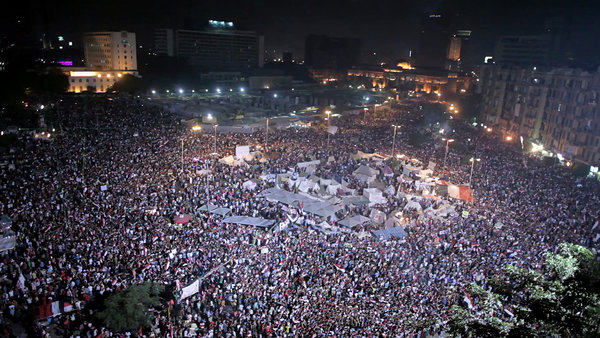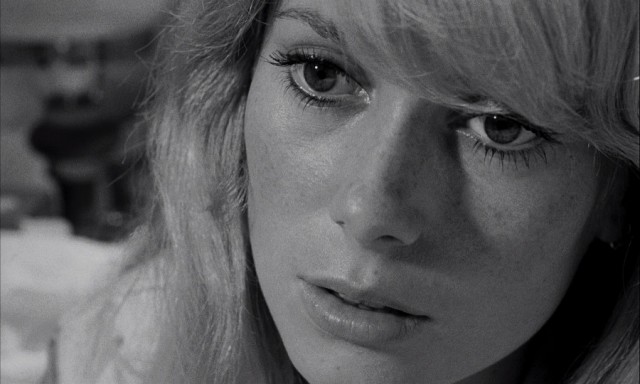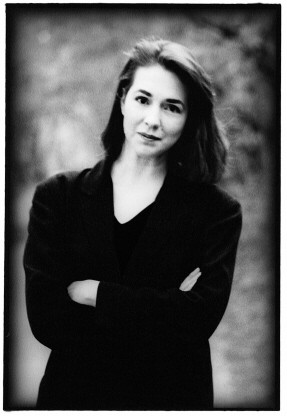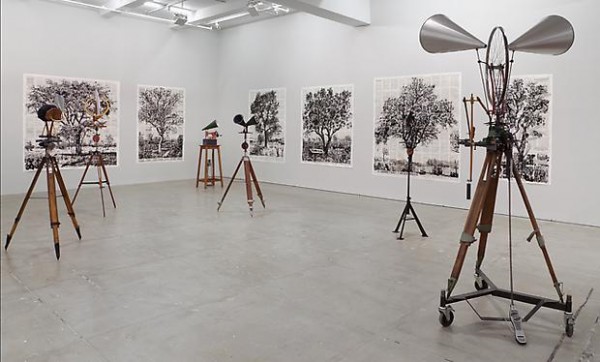
William Kentridge’s latest show at Marian Goodman is another multimedia wonder (photo courtesy Marian Goodman Gallery)
Marian Goodman Gallery
24 West 57th St. between Fifth & Sixth Aves.
Through October 26, free, 10:00 am – 6:00 pm
212-977-7160
www.mariangoodman.com
In his latest exhibit at the Marian Goodman Gallery in Midtown, “Second-hand Reading,” South African multidisciplinary artist William Kentridge examines the concepts of construction, deconstruction, and reconstruction in unique, creative, and, as always, playful ways as they relate to both the artist himself and the viewer. As he noted in “Drawing Lesson One: In Praise of Shadows,” the first of six hour-long Charles Eliot Norton Lectures he gave in the spring of 2012 during his one-year residency at Harvard, we are “made aware of our part in the construction of the image, our part in the construction of the illusion, but most importantly our part in the construction of ourselves. It is in the gap between the object and its representation that this energy emerges, the gap we fill in.” Over the course of the talks, which can be viewed here, Kentridge also discusses mistranslation, practical epistemology, meaning, shadows, words, seeing, the movement between images and ideas, anti-entropy, and life in the studio, where he makes all of his work.
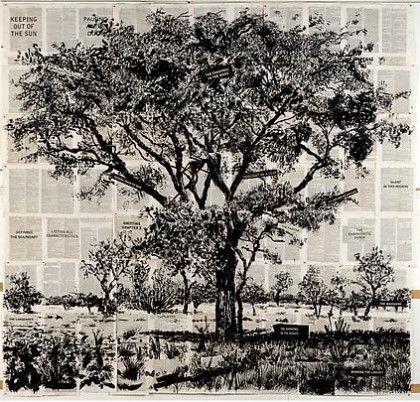
William Kentridge, “The Shrapnel in the Woods,” India ink on CRAGGS UNIVERSAL TECHNOLOGICAL DICTIONARY (1826), 2013 (photo courtesy Marian Goodman Gallery)
As complex as his talks can get, Kentridge also instills his trademark sense of humor and explores his very personal inclusion of the hand — and full body — of the artist, two elements that are central to the new show, which continues through October 26. “Second-hand Reading” is filled with energy, and its myriad rewards are indeed affected by how much constructing visitors do in their mind. The North Gallery is dominated by kinetic machines, including repurposed megaphones, sewing machines, a bicycle wheel, and a drum kit hanging from the ceiling, all of which must be operated by a gallery employee, who will do so for the asking. Surrounding the machines is a series of large-scale India ink drawings on pages from Craggs Universal Technology Dictionary, featuring trees on which Kentridge has added such phrases as “Tear & Repair,” “The Nicely Built City Never Resists Destruction,” and “The Death of Trees.” The trees not only represent life in South Africa but the source of the paper on which they are drawn; in today’s society, of course, less and less writing is being done on paper.
In the North Viewing Room, the triptych flip-book “NO, IT IS” consists of three extremely entertaining continuous and simultaneous flipbook videos (Workshop Receipts, The Anatomy of Melancholy, and Practical Enquiries) of black-and-white images and different-colored geometric shapes on pages from an old technical encyclopedia. As the pages turn, Kentridge walks across them, takes a seat, and dances with a woman; at the beginning and end, Kentridge’s hand can be seen opening and closing the book. The drawings used for the films hang on the walls of the small space.
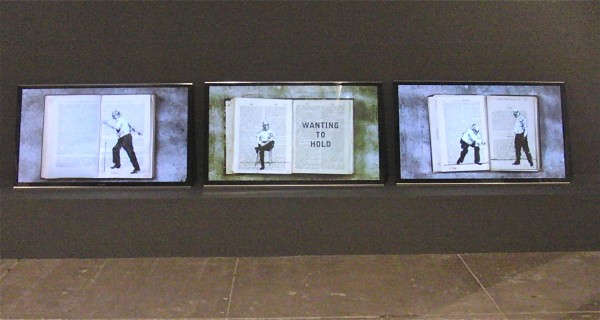
William Kentridge, “NO, IT IS,” triptych of three flipbook films, HD video, 2012 (photo by twi-ny/mdr)
In the Conference Room, linocuts of trees are printed on sheets taken from the Shorter Oxford English Dictionary and the Encyclopedia Britannica, while silkscreens on pages from the 1746 Septem Linguarum Calepinus, the 1757 AD Pandectas Duobus Tomis Dilftributus, and other books declare in bold red, “A Safe Space for Stupidity,” “The Full Stop Swallows the Sentence,” and “Against Argument (But Not This One),” phrases Kentridge wrote down while preparing the Harvard lectures.
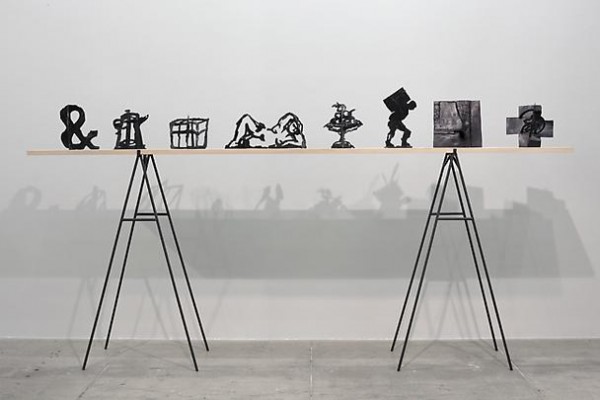
William Kentridge’s “Rebus” sculptures are best experienced from multiple angles (photo courtesy Marian Goodman Gallery)
In the South Gallery in the back, two rows of “Rebus” sculptures consist of black bronze works that are like puzzles, changing when viewed from different angles. A lithograph of nine black-and-white typewriters reminds us of how words were at one time put onto the page. “Let Us Enter the Chapter” and “All the Trees in the Library” comprise small drawings on pages of the Shorter Oxford English Dictionary with such words at the top as “Abuse,” “Advocate,” “Wrath,” “Void,” “Symptom,” “Graveyard,” and “Indecipherable.” The show culminates with the poetic seven-minute flipbook film “Second-hand Reading,” which is composed of the many disparate elements in the South Gallery as a concerned Kentridge makes his way across pages from Cassell’s Cyclopædia of Mechanics on which he has added such phrases as “Whichever page you open, there you are” and a cheerleader with a cross on her outfit waves flags as if sending a message, all set to a beautiful score by Neo Muyanga. The exhibit as a whole places Kentridge’s art very firmly in a different kind of age of mechanical reproduction while laying bare his thought process. He is “taking sense and deconstructing it, taking nonsense and seeing if sense can be constructed from it,” as he recently explained, and asking the viewer to participate in the ultimate creation of meaning. The title of the show itself evokes a multitude of meanings, as “second-hand” could refer to Kentridge’s reuse of found objects, the portrayal of his own actual hand, his breathing life into pages from old texts that people can now read in a new light, and the endless passage of time, which hovers over everything. But even more important, it’s all a helluva lot of fun.
(Kentridge fans can still see his visually stunning production of The Nose at the Metropolitan Opera on October 26 and in theaters October 26 and 30, and the Metropolitan Museum of Art just opened their latest Kentridge acquisition, “The Refusal of Time,” which runs through May 11. To read our 2011 twi-ny talk with Mr. Kentridge, please go here.)





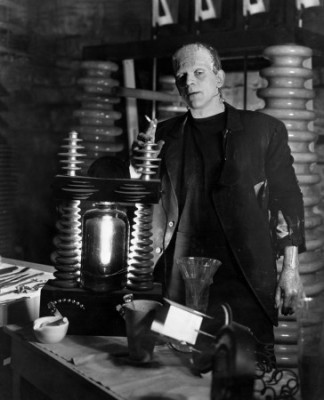
 At the start of James Whale’s Frankenstein, actor Edward Van Sloan, who plays Dr. Waldman in the film, steps out from behind a curtain and tells the audience that what they are about to see “is one of the strangest tales ever told. It deals with the two great mysteries of creation; life and death. I think it will thrill you. It may shock you. It might even horrify you. So, if any of you feel that you do not care to subject your nerves to such a strain, now’s your chance to uh, well — we warned you!” Instead of staying away, people flocked to the theaters, making Frankenstein such a hit that Universal produced a sequel, although it took longer than expected. At the beginning of Whale’s 1935 follow-up, Bride of Frankenstein, Mary Wollstonecraft Shelley (Elsa Lanchester) tells Percy Bysshe Shelley (Douglas Walton) and Lord Byron (Gavin Gordon), “The publishers did not see that my purpose was to write a moral lesson, the punishment that befell a mortal man who dared to emulate god,” letting them know that there was more to her story, picking up where the first movie left off. The Monster (Boris Karloff again, billed only by his last name) has survived the fire, and he is on the loose. Dr. Henry Frankenstein (Colin Clive, reprising his role as the godlike creator) has survived as well and is ready to finally marry his sweetheart, Elizabeth (Valerie Hobson, taking over for an ill Mae Clarke).
At the start of James Whale’s Frankenstein, actor Edward Van Sloan, who plays Dr. Waldman in the film, steps out from behind a curtain and tells the audience that what they are about to see “is one of the strangest tales ever told. It deals with the two great mysteries of creation; life and death. I think it will thrill you. It may shock you. It might even horrify you. So, if any of you feel that you do not care to subject your nerves to such a strain, now’s your chance to uh, well — we warned you!” Instead of staying away, people flocked to the theaters, making Frankenstein such a hit that Universal produced a sequel, although it took longer than expected. At the beginning of Whale’s 1935 follow-up, Bride of Frankenstein, Mary Wollstonecraft Shelley (Elsa Lanchester) tells Percy Bysshe Shelley (Douglas Walton) and Lord Byron (Gavin Gordon), “The publishers did not see that my purpose was to write a moral lesson, the punishment that befell a mortal man who dared to emulate god,” letting them know that there was more to her story, picking up where the first movie left off. The Monster (Boris Karloff again, billed only by his last name) has survived the fire, and he is on the loose. Dr. Henry Frankenstein (Colin Clive, reprising his role as the godlike creator) has survived as well and is ready to finally marry his sweetheart, Elizabeth (Valerie Hobson, taking over for an ill Mae Clarke).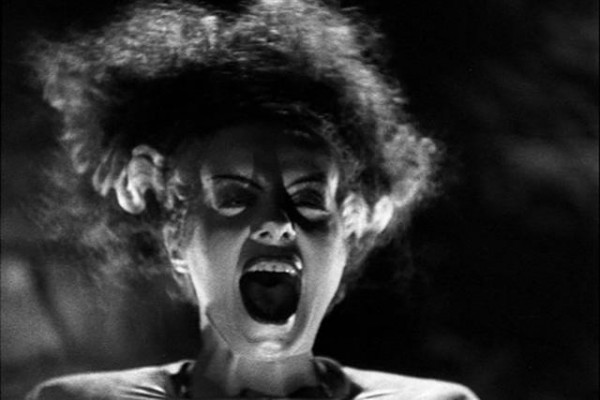
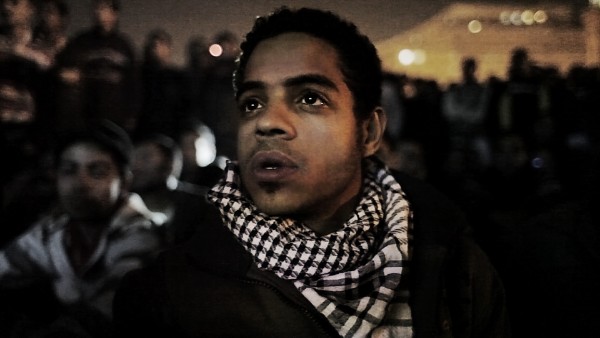
 “During the early days, we agreed to stay united no matter what,” Ahmed Hassan tells those around him in Jehane Noujaim’s powerful and important documentary The Square. “When we were united, we brought down the dictator. How do we succeed now? We succeed by uniting once again.” But Ahmed, one of several Egyptian revolutionaries who Noujaim follows for two years in the film, finds that it is not that easy to bring everyone together, as the government leaders continue to change and factions develop that favor the military and the Muslim Brotherhood. Putting her own life in danger, Noujaim (The Control Room, Startup.com) is right in the middle of it all as she shares the stories of Ahmed, a young man who is determined to see the revolution through until peace and justice prevail; Magdy Ashour, a member of the Muslim Brotherhood who must choose between his own personal beliefs and that of his power-hungry organization; and Khalid Abdalla, the British-Egyptian star of The Kite Runner and United 93 who becomes an activist like his father, serving as the revolution’s main link to the international community through the media and by posting videos. In The Square, a 2013 New York Film Festival selection, Noujaim also introduces viewers to human rights lawyer Ragia Omran, protest singer Ramy Essam, and filmmaker Aida El Kashef, none of whom are willing to give in even as the violence increases.
“During the early days, we agreed to stay united no matter what,” Ahmed Hassan tells those around him in Jehane Noujaim’s powerful and important documentary The Square. “When we were united, we brought down the dictator. How do we succeed now? We succeed by uniting once again.” But Ahmed, one of several Egyptian revolutionaries who Noujaim follows for two years in the film, finds that it is not that easy to bring everyone together, as the government leaders continue to change and factions develop that favor the military and the Muslim Brotherhood. Putting her own life in danger, Noujaim (The Control Room, Startup.com) is right in the middle of it all as she shares the stories of Ahmed, a young man who is determined to see the revolution through until peace and justice prevail; Magdy Ashour, a member of the Muslim Brotherhood who must choose between his own personal beliefs and that of his power-hungry organization; and Khalid Abdalla, the British-Egyptian star of The Kite Runner and United 93 who becomes an activist like his father, serving as the revolution’s main link to the international community through the media and by posting videos. In The Square, a 2013 New York Film Festival selection, Noujaim also introduces viewers to human rights lawyer Ragia Omran, protest singer Ramy Essam, and filmmaker Aida El Kashef, none of whom are willing to give in even as the violence increases.